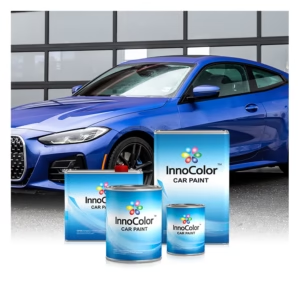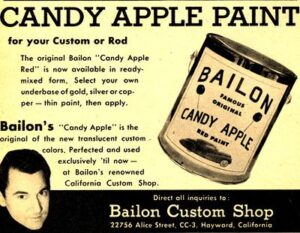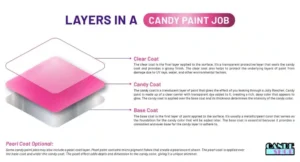Imagine cruising down a city street with the sun bright off your car’s paint job, its color shifting from deep red to a soft ruby as you drive. That’s the magic of candy paint — a finish that does more than turn heads — it defines personality, craftsmanship, and a love for automotive art.
This guide is crafted for car fans who want to understand what makes candy paint so special, from its roots to the technique behind its glow and how to care for it like a pro. It means candy paint is helping you in caring your car.
What Is Candy Paint
Candy paint is a layered automotive paint technique designed to produce a high-grade, deep finish with clear color saturation. Unlike standard car paints that are applied in one or two coats, candy paint involves a three-layer system:
-
Basecoat: A metallic or reflective coat, often silver or gold, that reflects light beneath the paint.
-
Candy Coat: A translucent colored layer that sits over the base, giving the paint its unique tone and depth.
-
Clear Coat: A glossy protective finish that seals the look, enhances shine, and protects against environmental damage.
This layering process gives candy paint its signature “wet” look and depth that shifts beautifully under light.
A Look at the Origins of Candy Paint

The candy paint style was born during the custom car revolution of the 1950s and 60s. Joe Bailon, a famous hot rod designer, created the first Candy Apple Red, inspiring countless groups.
The vibrant style took off especially within lowrider and muscle car cultures. Over the decades, candy paint has evolved into a premium custom finish — still synonymous with grace, craftsmanship, and individuality.
Why Candy Paint Stands Out
Candy paint isn’t just paint — it’s a commitment to automotive beauty. Here’s what sets it apart:
Eye-Catching Shine: The layered effect creates a rich gloss that standard finishes can’t match.
Custom Combinations: By mixing basecoat tones and candy colors, no two candy paint jobs are exactly alike.
Cultural Relevance: From vintage hot rods to modern show cars, candy paint holds a timeless place in automotive culture.
The Process: How Candy Paint Is Applied
Applying candy paint is a skillful, time-consuming process. Here’s a step-by-step breakdown:
Step 1: Surface Prep
The car’s exterior must be sanded, smoothed, and cleaned. Imperfections are magnified under candy paint, so this step is critical.
Step 2: Laying the Basecoat
A metallic base — typically silver, chrome, or gold — is applied evenly. This layer reflects light through the candy color coat.
Step 3: Candy Coat Application
A clear candy layer is carefully sprayed in multiple coats. The depth of color depends on how many coats are applied.
Step 4: Clear Coat Finish
Several coats of clear coating or urethane are applied to protect the paint and intensify the gloss. This layer is then polished to a glass-like shine.
Top Candy Paint Colors in the Custom Scene
Some colors have become iconic in the world of candy-painted vehicles:
-
Candy Apple Red: The original and still one of the most popular
-
Cobalt Blue: A dazzling electric tone that pops on any model
-
Emerald Green: Deep, sophisticated, and perfect for classic cars
-
Tangerine Orange: Bright and bold — ideal for making a statement
-
Royal Purple: A unique hue for luxury or muscle cars
Each color reacts differently depending on the basecoat used and the number of candy layers applied.
Candy Paint vs. Other Paint Types
| Feature | Candy Paint | Metallic Paint | Pearl Finish | Solid Color |
|---|---|---|---|---|
| Shine and Depth | High | Medium | High | Low |
| Uniqueness | High | Low | Medium | Low |
| Skill Required | High | Low | Medium | Low |
| Maintenance Needed | High | Low | Medium | High |
Candy paint is clearly more laborious and demands a higher skill level, but the payoff is a visually stunning result that stands apart.
Cost to Get a Candy Paint Job
A professionally done candy paint job typically costs between 4,000 to 12,000 depending on several factors:
-
The size and shape of your vehicle
-
Number of coats applied
-
Brand and quality of materials
-
Labor costs based on painter’s skill and experience
DIY kits are available starting at around 300, but this finish is best left to professionals unless you’re experienced in custom auto paint work.
Pros and Cons: Is Candy Paint Right for You
Benefits:
-
Custom finish that stands out from the crowd
-
Enhances vehicle’s resale value, especially for collectors
-
A wide range of colors and tones to choose from
Drawbacks:
-
Costly due to materials and labor
-
Prone to showing imperfections if not applied properly
-
Touch-ups can be difficult and require blending entire panels
How to Keep Candy Paint Looking Fresh
To preserve your candy paint’s vibrant appearance, follow these tips:
-
Use Gentle Car Soaps: Stick with pH-balanced or specially-formulated car shampoos
-
Avoid Automatic Car Washes: Brushes and harsh chemicals can dull the finish
-
Dry by Hand: Use microfiber towels to prevent water spotting
-
Wax or Ceramic Coat Regularly: This adds a protective layer against UV rays and environmental damage
-
Store Properly: Whenever possible, park in a garage or under a car cover
Choosing the Right Shop for the Job
A successful candy paint job starts with choosing a skilled painter. When searching, look for:
-
A portfolio showing past candy paint work
-
Positive customer reviews and recommendations
-
Clean, professional workspaces
-
A willingness to explain their process and timeline
Avoid shops that don’t specialize in custom or show-quality finishes — you get what you pay for.
Final Thoughts: The Candy Paint Experience
Getting your car candy painted isn’t just a cosmetic choice — it’s an experience. You’re making a statement every time you take it out for a spin. With the right paint shop, proper care, and a bit of vision, your car can become a rolling piece of art.
Whether you’re restoring a classic or customizing a modern vehicle, candy paint brings a unique, unforgettable glow. It’s more than paint — it’s personality in motion.
